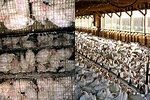John Ikerd: CAFO Defenders’ Comments & Questions
By johnikerd | April 19, 2017
I am frequently asked to speak at public events organized by people concerned about the impacts of Concentrated Animal Feeding Operators or CAFOs on their communities. I am invariably asked to respond to comments and questions used as “talking points” by defenders of CAFOs. I thought it might be useful to share my responses to some of the more common questions and comments. I will post a few periodically on my blog.
Question: Farmers with CAFO are just trying to make a living. Why are you against farmers?
 Response: I am not against farmers. I grew up on a farm and have spent my entire professional life working with farmers. I just don’t believe that operating a CAFO is real farming. Real farmers respect their neighbors and don’t knowingly pollute the air, soil, and water with noxious odors and chemical and biological wastes. There are lots of better ways to make a living on a farm than by operating a CAFO. I’m sure some CAFO operators do the best they can to manage their operations responsibly, but there are fundamental flaws in the industrial system of agricultural production, which is epitomized by CAFOs. Undoubtedly, there are good people operating CAFOs who just got caught up in a bad system. They borrowed a lot of money to build a CAFO before they discovered that operating a CAFO is not real farming.
Response: I am not against farmers. I grew up on a farm and have spent my entire professional life working with farmers. I just don’t believe that operating a CAFO is real farming. Real farmers respect their neighbors and don’t knowingly pollute the air, soil, and water with noxious odors and chemical and biological wastes. There are lots of better ways to make a living on a farm than by operating a CAFO. I’m sure some CAFO operators do the best they can to manage their operations responsibly, but there are fundamental flaws in the industrial system of agricultural production, which is epitomized by CAFOs. Undoubtedly, there are good people operating CAFOs who just got caught up in a bad system. They borrowed a lot of money to build a CAFO before they discovered that operating a CAFO is not real farming.
Comment: It’s difficult for young people who want to farm to get a start today because of the large upfront investment in land, equipment, and such. Many farmers say that CAFOs are the only way their sons or daughters can continue the family’s farming tradition.
 Response: It’s true that it’s easier to get upfront funding or long term loans to start a CAFO than it is to start other types of agricultural operations. Banks and farm lending agencies consider CAFO loans to be less risky because the livestock are typically produced under a comprehensive corporate contract where the corporations own the livestock, provide the feed, make all the major decisions, take most of the financial risks. The CAFO operator is typically paid a predetermined amount per head produced or assured a specific profit margin regardless of the cost of feed or market prices. It’s also easy for lenders can get USDA guarantees that insure up to 80% repayment of CAFO loans. However, CAFO operators then end up as little more than corporate hired hands with minimum wage jobs. Their main responsibilities are to keep the feeders, waters, and ventilation fans running and to dispose of the dead animals and tons of manure. Furthermore, before the loan is paid off, contractors often require major renovation, or perhaps even new buildings, which will require another long-term loan. There are far better ways to get started in farming.
Response: It’s true that it’s easier to get upfront funding or long term loans to start a CAFO than it is to start other types of agricultural operations. Banks and farm lending agencies consider CAFO loans to be less risky because the livestock are typically produced under a comprehensive corporate contract where the corporations own the livestock, provide the feed, make all the major decisions, take most of the financial risks. The CAFO operator is typically paid a predetermined amount per head produced or assured a specific profit margin regardless of the cost of feed or market prices. It’s also easy for lenders can get USDA guarantees that insure up to 80% repayment of CAFO loans. However, CAFO operators then end up as little more than corporate hired hands with minimum wage jobs. Their main responsibilities are to keep the feeders, waters, and ventilation fans running and to dispose of the dead animals and tons of manure. Furthermore, before the loan is paid off, contractors often require major renovation, or perhaps even new buildings, which will require another long-term loan. There are far better ways to get started in farming.
Question: How can young farmers possibly make a living on a small farm by selling at farmers markets, producing organic vegetables, running a CSA, or pursuing any of these so-called viable alternatives to industrial agriculture?
 Response: It isn’t easy, but it can be and is being done. The number of farmers markets in the U.S. has increased from less than 1,800 to more 8,000 over the past 20 years, a four-fold increase. The number of CSAs has increased from virtually none in the early 1990s to more than 12,000 in the 2012 census of agriculture, with more than 50,000 farmers selling direct to their customers by one way or another. No one really knows how many farmers are making a living by selling to local customers because there isn’t a systemic means of collecting such statistics. The key to financial success is to find customers who are willing to pay the full costs of non-industrial, sustainably produced food. Major retail market surveys indicate that more than one-third of American consumers are willing to pay premium prices for non-industrial food products that meet their standards of food safety and nutrition, and are produced by means that conform to their social and ethical values. Current production of such products make up less than one-tenth of the total retail food market. So the potential market is already at least three times as large as the current supply and is growing. It may not be easy for non-industrial farmers to connect with these customers, but the potential for economic success certainly exists.
Response: It isn’t easy, but it can be and is being done. The number of farmers markets in the U.S. has increased from less than 1,800 to more 8,000 over the past 20 years, a four-fold increase. The number of CSAs has increased from virtually none in the early 1990s to more than 12,000 in the 2012 census of agriculture, with more than 50,000 farmers selling direct to their customers by one way or another. No one really knows how many farmers are making a living by selling to local customers because there isn’t a systemic means of collecting such statistics. The key to financial success is to find customers who are willing to pay the full costs of non-industrial, sustainably produced food. Major retail market surveys indicate that more than one-third of American consumers are willing to pay premium prices for non-industrial food products that meet their standards of food safety and nutrition, and are produced by means that conform to their social and ethical values. Current production of such products make up less than one-tenth of the total retail food market. So the potential market is already at least three times as large as the current supply and is growing. It may not be easy for non-industrial farmers to connect with these customers, but the potential for economic success certainly exists.
Question: Even if farmers can make a living in a small farm, it would take a lot of work to farm the way they would have to farm to make enough money to support a family. Most young people these days don’t want to work that hard. How could you ever find enough young people who willing to farm to replace the animal products produced in CAFOs?
 Answer: There are many new technologies, such as portable electric fences, front-end loaders for small tractors, large round hay bales and balage for forages, hoop houses for hogs, chicken tractors, and mobile hen houses that have taken much of the drudgery out of small-scale livestock and poultry production. I certainly wouldn’t expect anyone to willingly choose to go back to the ways we farmed when I was a kid. There was a lot of just plain boring, repetitive, hard work. Operating a profitable small farm is still challenging, but it doesn’t involve the drudgery of farming in the 1940s or 1950s. Perhaps more important, many young people today are willing to work hard, if the work is interesting and intellectually challenging and they are working for themselves. Keeping the automatic feed and water systems working and carrying off the dead animals from CAFOs doesn’t seem like a very rewarding way of life. Young people who feel a “calling” to be a farmer, and are willing to think as well as work, can make a decent living on a small farm. The promise for the future of farming is the large and growing numbers of intelligent, thoughtful millennials, many with young families, who are increasingly attending the major sustainable agriculture conferences all across the country. Most of these young people who are answering the calling to farm understand there is more to a life of quality than just making money or trying to live up to someone else’s expectations.
Answer: There are many new technologies, such as portable electric fences, front-end loaders for small tractors, large round hay bales and balage for forages, hoop houses for hogs, chicken tractors, and mobile hen houses that have taken much of the drudgery out of small-scale livestock and poultry production. I certainly wouldn’t expect anyone to willingly choose to go back to the ways we farmed when I was a kid. There was a lot of just plain boring, repetitive, hard work. Operating a profitable small farm is still challenging, but it doesn’t involve the drudgery of farming in the 1940s or 1950s. Perhaps more important, many young people today are willing to work hard, if the work is interesting and intellectually challenging and they are working for themselves. Keeping the automatic feed and water systems working and carrying off the dead animals from CAFOs doesn’t seem like a very rewarding way of life. Young people who feel a “calling” to be a farmer, and are willing to think as well as work, can make a decent living on a small farm. The promise for the future of farming is the large and growing numbers of intelligent, thoughtful millennials, many with young families, who are increasingly attending the major sustainable agriculture conferences all across the country. Most of these young people who are answering the calling to farm understand there is more to a life of quality than just making money or trying to live up to someone else’s expectations.
More to come…